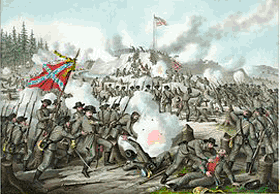 |
Civil War Battles |
|
State War Records |
| AL - AK - AZ - AR - CA - CO - CT - DE - FL - GA - HI - ID - IL - IN - IA - KS - KY - LA - MA - MD - ME - MI - MN - MS - MO - MT - NE - NV - NH - NJ - NM - NY - NC - ND - OH - OK - OR - PA - RI - SC - SD - TN - TX - UT - VT - VA - WA - WV - WI - WY |
The Battle of Fort Sanders/Fort Louden
November 29, 1863 in Knox County, Tennessee
 |
|||||||||||||||||||||
|
Fort Sanders was a key to the defense of Knoxville, which stood on the right bank of the Holston River and on the East Tennessee & Georgia Railroad. To protect the town, the Confederates built a number of fortifications, including Fort Louden in the northwest quadrant.
In the summer of 1863, a Union army invaded East Tennessee and occupied Knoxville, and in November, Lt. Gen. James Longstreet launched his Knoxville Campaign to capture or drive the Union army out. In attempting to take Knoxville, the Confederates decided that Fort Sanders was the only vulnerable place where they could penetrate Maj. Gen. Ambrose E. Burnside's fortifications, which enclosed the city, and successfully conclude the siege, already a week long. As the Confederates approached the town, cavalry under Brig. Gen. William P. Sanders intercepted them about a mile from the fort, delayed their advance, and gained for the Union precious time to strengthen Knoxville's defenses. In the fighting, Sanders fell mortally wounded, and Fort Louden was renamed Fort Sanders in his honor.
Fort Sanders stood on an eminence that fell off sharply to the northwest of Knoxville, making impossible an exposed advance to within about 200 yards. From there the approach was treacherous. A line of entrenched pickets skirted a field of stumps to which old telegraph wire was fastened. Beyond the field and surrounding the fort was a ditch about 12-feet wide and from 4-10-feet deep, the sides of which were almost vertical. The final obstruction was a sharply inclined parapet, difficult to mount because the berm at its foot had been cut away.
Longstreet believed he could assemble a storming party, undetected at night, below the fortifications and, before dawn, overwhelm Fort Sanders by a coup de main. At dawn on the 29th, following a brief artillery barrage directed at the fort's interior, 3 Confederate brigades charged. They were covered by the fire of sharpshooters in trenches seized from the Union pickets the night before. The wire entanglements caused only momentary delay, but when the Confederates reached the edge of the ditch, they stopped, unsure of what to do. Under murderous rifle and artillery fire, they began firing at the fort. Officers and color-bearers leaped into the ditch. Lacking ladders, they had to hoist men onto the parapet, but the only Confederates to enter the fort became prisoners of war.
In about 20 minutes, the confederates grudgingly withdrew. An attack by a fourth brigade was quickly repulsed. Longstreet undertook his Knoxville expedition to divert Union troops from Chattanooga and to get away from Gen. Braxton Bragg, with whom he was engaged in a bitter feud. Shortly thereafter, Longstreet received word of Gen. Braxton Bragg's defeat at Chattanooga and retired northeastward. His failure to take Knoxville scuttled his purpose.
This was the decisive battle of the Knoxville Campaign. This Confederate defeat, plus the loss of Chattanooga on November 25, put much of East Tennessee in the Union camp.
